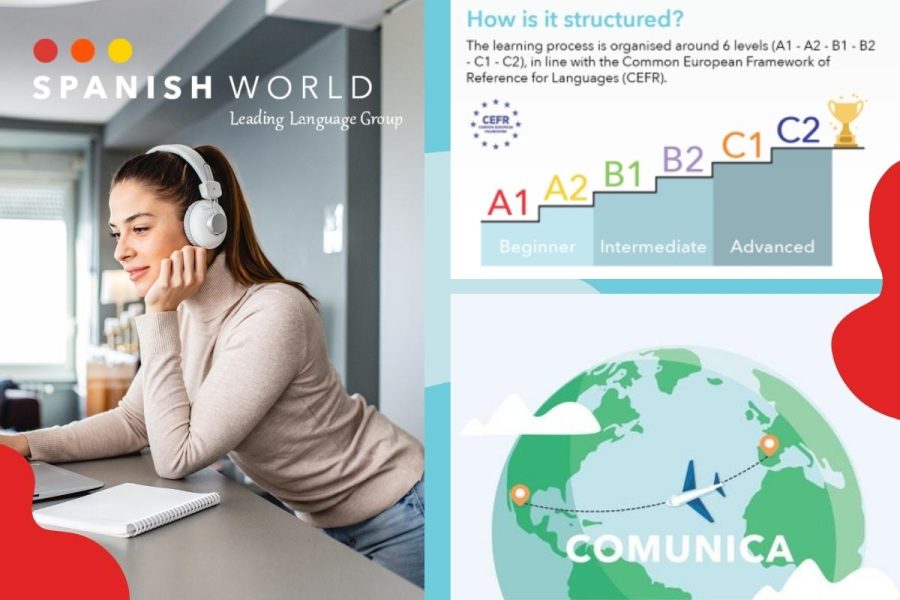Learn Spanish Fast and Easy Online

Live Online Classes with Native Experts And Self-Paced Spanish Courses
What do you get in our online Spanish class?
Native, Expert, Awesome Teachers!
Beginner, Intermediate, and Advanced Spanish Classes
Scientifically Backed Blended Learning System
A Portal into the Awesome World of Hispanity!
Your smooth learning experience is our top priority. Read student testimonials here:

Great way to learn Spanish. The online exercises are clear and well organized. Particularly helpful are the live group sessions held each week.
-Mark
I highly recommend Comunica for those who have a busy schedule but want to learn Spanish effectively. The pace of learning is completely customizable.
-Susan
Nicely structured courses and learn at your own pacing. Highly recommend for anyone wanting to learn Spanish.
-Ash
About the Comunica Live Online Spanish Course:
-
Comprehensive Spanish curriculum
-
Private, small-group, and mixed options
-
Beginner to advanced level (from A1 to B2 of CEFR)
-
Desktop and mobile friendly
-
Certificate course
-
1-2 hour lessons
-
60-page E-book per module
-
13 modules
-
Tens of thousands of hours of digital content
-
Video lessons and an original miniseries
Course Schedule: A1.1 (Madrid) for Total Beginners
| Group | Lesson day, date of first lesson, lesson timing (Enquire now to join in) |
|---|---|
| A | CRASH COURSE, Tuesdays and Thursdays, starting May 29, Evenings (7:30 – 9:00 pm) [OPEN SLOTS] |
| B | Mondays, starting May 26, Afternoons (12:00 – 1:30 pm) |
| C | Mondays, starting May 26, Evenings (7:30 – 9:00 pm) |
| D | |
| E | Tuesdays, starting May 27 Evenings (7:30 – 9:00 pm) |
| F | Wednesdays, starting May 28, Afternoons (12.00 – 1:30 pm) |
| G | Wednesdays, starting May 28, Evenings (7:30 – 9:00 pm) |
| H | Thursdays, starting May 29, Evenings (8:00 – 9:30 pm) |
| I | Fridays, starting May 30, Evenings (7:30 – 9:00 pm) |
| J | Saturdays, starting May 31, Mornings (10:30 am – 12:00 pm) |
| K | Saturdays, starting May 31 Afternoons (3:00 – 4:30 pm) |
| L | Mondays, starting June 2, Mornings (10:30 – 12:00 pm) |
| M | Mondays, starting June 2 Evenings (7:30 – 9:00 pm) |
What does A1.1 (Madrid) mean?
A1.1 refers to the CEFR level. Madrid is the name of our course. You can read about all the different courses of our COMUNICA program with this link:
[LEARN MORE ABOUT SMALL GROUP COURSES FOR ADULTS]
Do you only offer courses for total beginners?
NO! Click the button below to take our Free Assessment and see all our upcoming intermediate and advanced courses:
[TEST YOUR SPANISH AND SEE COURSE SCHEDULES FOR ALL LEVELS]
Can I take this course by myself?
Yes, you can take it by yourself with a teacher, or start learning Spanish completely on your own.

Quick Registration
RECENT POSTS
I learnt the different weights of racquets and the impact they would have in your game as a kid. The obvious premise is that the heavier a racquet is, the more power it can produce – but it also takes more strength to swing it.
Does Spanish World Malaysia offer in-person classes?
All of our Spanish group courses are online since the pandemic. We know some students are thinking about face to face courses when they contact us, but we’ve found our online courses have a lot of advantages in terms of cost and convenience, and are a great solution for people who are serious about learning Spanish for the long term, as learning a language is really more like a marathon than a sprint.
Where in the world do they speak Spanish?
Spanish is an official language in 21 countries, mainly in Central America, South America, and Spain. Here are some of the countries where Spanish is spoken the most:
- Mexico: With a population of over 130 million people, Mexico is the most populous Spanish-speaking country in the world.
- Spain: As the birthplace of the Spanish language, Spain is home to over 47 million speakers of Spanish.
- Colombia: With a population of over 50 million people, Colombia is the third most populous Spanish-speaking country in the world.
- Argentina: With a population of over 44 million people, Argentina is the fourth most populous Spanish-speaking country in the world.
- Peru: With a population of over 32 million people, Peru is the fifth most populous Spanish-speaking country in the world.
Other countries where Spanish is widely spoken include Venezuela, Chile, Ecuador, Guatemala, Cuba, Bolivia, the Dominican Republic, Honduras, Paraguay, El Salvador, Nicaragua, Costa Rica, Puerto Rico, and Panama.
Spanish is also spoken in parts of the United States, particularly in states with large Hispanic populations such as California, Texas, Florida, and New York.
How many Spanish-speakers are there?
According to Ethnologue, a database of world languages, there are approximately 460 million native speakers of Spanish worldwide as of 2021, making it the second most spoken language in terms of native speakers, after Mandarin Chinese.
Additionally, there are an estimated 90 million people who speak Spanish as a second language, bringing the total number of Spanish speakers worldwide to around 550 million!
What is the difference between Spanish spoken in Spain and Latin America?
Pronunciation: Spanish spoken in Spain has a distinct pronunciation, with a “th” sound for “c” and “z” before “e” and “i”. In Latin America, this sound is usually pronounced as an “s” sound. Additionally, the “s” sound is often dropped at the end of words and sometimes in the middle of words in Latin America, while it is typically pronounced in Spain.
Vocabulary: There are many words that are used differently in Spain and Latin America, or that have different words altogether. For example, in Spain, a “coche” is a car, while in Latin America it’s more commonly called an “auto” or “carro”. Similarly, in Spain, “ordenador” is used for computer, while in Latin America it’s more commonly called a “computadora”.
Grammar: While the basic grammar rules of Spanish are the same in Spain and Latin America, there are some differences in usage. For example, in Spain, the informal second-person singular pronoun “tú” is used more frequently than in Latin America, where “usted” is often preferred. Additionally, there are some variations in verb conjugation and use of prepositions and articles.
Culture: Spanish culture varies widely between Spain and Latin America, and this can be reflected in the language. For example, certain words and phrases may be more commonly used in Spain to describe certain cultural traditions or events, while different words may be used in Latin America.













